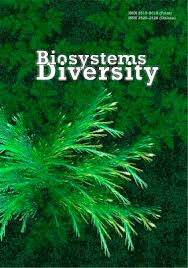Impact of lead on the amount of chlorophyll and carotenoids in the leaves of Triticum durum and T. aestivum, Hordeum vulgare and Avena sativa
Impact of lead on the amount of chlorophyll and carotenoids in the leaves of Triticum durum and T. aestivum, Hordeum vulgare and Avena sativa
Author(s): H. SouahiSubject(s): Agriculture, Energy and Environmental Studies, Environmental Geography
Published by: Дніпропетровський національний університет імені Олеся Гончара
Keywords: species response; pigments; contaminated soils; oxidative damage; stress factor;
Summary/Abstract: Lead is one of the most dangerous pollutants to both the environment and humans. It causes structural changes in photosynthetic apparatus and reduced biosynthesis of chlorophyll pigments inhibits carbon metabolism. The aim of our study was to determine the dynamics of photosynthetic pigments in leaves of wheat (Triticum durum and T. aestivum), barley (Hordeum vulgare) and oats (Avena sativa) at different lead acetate, Pb(CH3COO)2 levels: 0, 0.15, 0.30 and 0.60 g/L. The results of this research indicate that these concentrations significantly affected chlorophyll content of H. vulgare and A. Sativa as compared to T. durum and T. aestivum. Analysis of variance showed that lead concentration and interaction between cereal species had a significant effect on all chlorophyll characteristics at 0.1% probability and on carotenoids contents at 1% significance. Lead acetate in 0.3 and 0.6 g/L concentrations had a highly significant effect on chlorophylla, band carotenoids in H. vulgare seedlings, its carotenoid contents increased from 0.002 mg/g FW at 0 g/L to 0.107 mg/g FW at 0.6 g/L, whereas its chlorophyll content decreased under heavy metal stress, corresponding to the concentration of the metal ion. Carotenoids of A. Sativa were not affected compared to Chl a and Chl b, while higher concentrations significantly increased chlorophyll contents of the seedlings from 1.384 mg/g FW of total chlorophyll at 0 g/L to 1.883 mg/g FW at 0.6 g/L. The increased amount of carotenoids was indicative of the formation of free radicals in plants under heavy metal stress, while decreased levels of chlorophyll content were an indication of reduction in the growth of the plants leading to decrease in the yield. It is suggested that chlorophyll content can be adopted as a very useful in vivo indicator of heavy metal toxicity.
Journal: Biosystems Diversity
- Issue Year: 29/2021
- Issue No: 3
- Page Range: 207-210
- Page Count: 4
- Language: English

